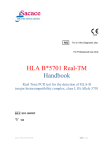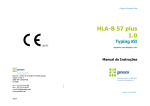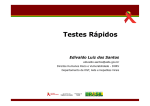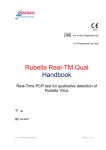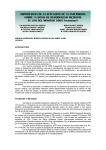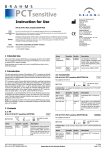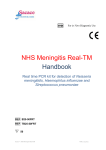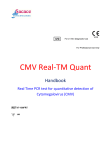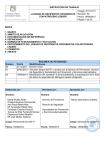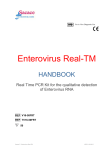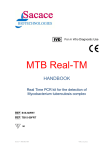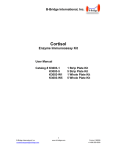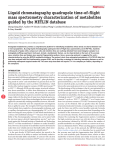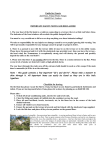Download HLA B5701 Real
Transcript
For in Vitro Diagnostic Use For Professional Use Only HLA B*5701 Real-TM Handbook Real Time PCR test for the detection of HLA-B (major histocompatibility complex, class I, B) Allele 5701 REF H53-100FRT 100 NAME HLA B*5701 Real-TM INTRODUCTION Abacavir is a nucleoside reverse-transcriptase inhibitor with activity against the human immunodeficiency virus (HIV), available for once-daily use in combination with other antiretroviral agents, that has shown efficacy, few drug interactions, and a favorable long-term toxicity profile. The most important adverse effect of abacavir that limits its use in therapy and mandates a high degree of clinical vigilance is an immunologically mediated hypersensitivity reaction affecting 5 to 8% of patients during the first 6 weeks of treatment. Symptoms of a hypersensitivity reaction to abacavir are nonspecific and include combinations of fever, rash, constitutional symptoms, gastrointestinal tract symptoms, and respiratory symptoms that become more severe with continued dosing. Immediate and permanent discontinuation of abacavir is mandated, resulting in a rapid reversal of symptoms. Subsequent rechallenge with abacavir is contraindicated, since it can result in a more severe, rapid, and potentially life-threatening reaction. In 2002, an association between a diagnosis of hypersensitivity reaction to abacavir and carriage of the major histocompatibility complex class I allelee HLA-B*5701 was reported independently by several independent studies. Studies of cohorts with HIV infection have also shown that avoiding abacavir in HLA-B*5701– positive patients significantly reduced the incidence of suspected hypersensitivity reaction up to 0,5%. Many clinical studies recommend for this reason, the pharmacogenetic molecular testing of the carriage of the major histocompatibility complex class I allelee HLA-B*5701 in all HIV positive patients treated with abacovir. HLA-B*5701 Real-TM test can predict who will develop a severe allergic reaction to the antiHIV drug abacavir as the presence of HLA-B*5701 is significantly associated with an abacavir hypersensitivity. INTENDED USE HLA B*5701 Real-TM is a Real-Time amplification test for the detection of HLA-B (major histocompatibility complex, class I, B) Allele 5701 in the biological materials. The kit HLA B*5701 Real-TM can be used as screening test for the prevention of abacavir hypersensitivity reactions. PRINCIPLE OF ASSAY HLA B*5701 Real-TM Test is based on two major processes: isolation of genomic DNA from specimens and Real Time amplification with allele specific primers. The real-time PCR monitoring of fluorescence intensities allows the accumulating product detection without reopening of reaction tubes after the PCR run. HLA B*5701 Real-TM PCR kit is a qualitative test which contains the Internal Control IC (human beta-globine gene), which allows to control the presence of cellular material in the sample. PRODUCT USE LIMITATIONS All reagents may exclusively be used in in vitro diagnostics. Use of this product should be limited to personnel trained in the techniques of DNA amplification (EN375). Strict compliance with the user manual is required for optimal PCR results. Attention should be paid to expiration dates printed on the box and labels of all components. Do not use a kit after its expiration date. QUALITY CONTROL In accordance with Sacace’s ISO 13485-Certified Quality Management System, each lot is tested against predetermined specifications to ensure consistent product quality. MATERIALS PROVIDED Reagent Description Volume, ml Amount PCR-mix-1-FRT HLA colorless clear liquid 0.6 2 tubes RT-PCR-mix-2-FL colorless clear liquid 0.3 2 tubes Polymerase (TaqF) colorless clear liquid 0.03 2 tubes TE-buffer colorless clear liquid 0.07 2 tubes Positive Control DNA HLA B*5701 and human DNA (C+) colorless clear liquid 0.2 1 tube Negative Control (C–)* colorless clear liquid 0.5 4 tubes * must be used in the isolation procedure as Negative Control of Extraction. MATERIALS REQUIRED BUT NOT PROVIDED • DNA extraction kit. • Disposable powder-free gloves. • Pipettes (adjustable). • Sterile pipette tips with aerosol filters up to 200 µl. • Tube racks. • Vortex mixer. • Desktop centrifuge with a rotor for 2-ml reaction tubes. • PCR box. • Personal thermocycler (for example, Rotor-Gene 6000/Q (Qiagen); iQ5 (Bio-Rad, USA), or equivalent). • Disposable polypropylene microtubes for PCR or PCR-plate • Refrigerator for 2–8 °C. • Deep-freezer for ≤ –16 °C. • Waste bin for used tips. STORAGE INSTRUCTIONS The kit HLA B*5701 Real-TM must be stored at or below minus 16 °C when not in use. The kit can be shipped at 2-8°C for 3-4 days but should be stored at -20°C immediately on receipt. PCR-mix-1-FRT HLA is to be kept away from light. STABILITY HLA B*5701 Real-TM is stable up to the expiration date indicated on the kit label. The product will maintain performance through the control date printed on the label. The shelf life of reagents before and after the first use is the same, unless otherwise stated. Exposure to light, heat or humidity may affect the shelf life of some of the kit components and should be avoided. Repeated thawing and freezing of these reagents should be avoided, as this may reduce the sensitivity. WARNINGS AND PRECAUTIONS In Vitro Diagnostic Medical Device For In Vitro Diagnostic Use Only 1. Wear disposable gloves, laboratory coats and eye protection when handling specimens and reagents. Thoroughly wash hands afterward. 2. Do not pipette by mouth. 3. Do not eat, drink, smoke, apply cosmetics, or handle contact lenses in laboratory work areas. 4. Do not use a kit after its expiration date. 5. Dispose of all specimens and unused reagents in accordance with local regulations. 6. Biosafety Level 2 should be used for materials that contain or are suspected of containing infectious agents. 7. Clean and disinfect all spills of specimens or reagents using a disinfectant such as 0,5% sodium hypochlorite, or other suitable disinfectant. 8. Avoid contact of specimens and reagents with the skin, eyes and mucous membranes. If these solutions come into contact, rinse immediately with water and seek medical advice immediately. 9. Material Safety Data Sheets (MSDS) are available on request. 10. Use of this product should be limited to personnel trained in the techniques of DNA amplification. 11. PCR reactions are sensitive to contamination. Measures to reduce the risk of contamination in the laboratory include physically separating the activities involved in performing PCR in compliance with good laboratory practice. 12. Workflow in the laboratory must proceed in a uni-directional manner, beginning in the Extraction Area and moving to the Amplification and Detection Area. Do not return samples, equipment and reagents in the area where you performed previous step. Some components of this kit contain sodium azide as a preservative. Do not use metal tubing for reagent transfer. Sampling of biological materials for PCR-analysis, transportation, and storage are described in details in the handbook of the manufacturer. It is recommended that this handbook is read before beginning of the work. SAMPLE COLLECTION, STORAGE AND TRANSPORT HLA B*5701 Real-TM can analyze genomic DNA extracted from: • whole blood: Collect 2 ml of blood to a tube with 0.2 ml of 3% EDTA solution. Invert a closed tube several times to ensure proper mixing. Blood samples should be stored at 2–8 °C for up to 48 h • Oropharyngeal swabs are taken with a sterile probe with a cotton tip. After swabbing, the probe should be placed to a tube with 0.5 ml of “Transport Medium for Storage and Transportation Respiratory Swabs” (REF 958). The probe should be broken off at the score mark so that the tube is tightly closed. The sample should be stored at 2–8 °C for up to 3 days. Transportation of clinical specimens must comply with country, federal, state and local regulations for the transport of etiologic agents. DNA ISOLATION The following isolation kits are recommended: • DNA/RNA-Prep (Sacace, REF K-2-9). Extract DNA according to the manufacturer’s instruction. Whole blood samples should be treated with “Hemolytic” ( REF 137-CE) before adding the lysis solution. To do this, add 1.0 ml of “Hemolytic” and 0.1 ml of whole blood to a 1.5-ml tube. Carefully vortex. Incubate the tubes at room temperature for 5 min, vortex, and incubate for 5 min once again. Centrifuge (8,000 rpm, 2 min). Remove and discard the supernatant. Leukocyte sediment should be immediately lysed; otherwise, it should be stored frozen at or below minus 16°C for up to 3 days or at or below minus 68°C for a long time. Prior to DNA extraction from throat swabs placed in “Transport Medium for Storage and Transportation of Respiratory Swabs” ( REF 957-CE), thoroughly mix, and then briefly vortex the samples. REAGENT PREPARATION 1. Prepare the reaction mixture. Per one reaction: 10 µl of PCR-mix-1-FRT HLA 5 µl of RT-PCR-mix-2-FL 0.5 µl of polymerase (TaqF) Add one extra reaction when calculating the reaction mixture volume. Volume of the reagents for specified number of samples, µl Number of (one extra reaction is included) samples PCR-mix-1-FRT HLA RT-PCR-mix-2-FL Polymerase (TaqF) 6 70 35 3.5 11 120 60 6.0 18 190 95 9.5 2. Thoroughly vortex prepared mixture, make sure there are no drops on the wall of the tubes. 3. Take the required number of the PCR tubes for amplification of clinical and control samples. Transfer 15 µl of prepared reaction mix to each tube. 4. Add 10 µl of DNA samples obtained from clinical or control samples at the stage of DNA extraction into prepared tubes. 5. Carry out control amplification reactions: NCA - Add 10 µl of TE-buffer to the tube labeled NCA (Negative Control of Amplification). - Add 10 µl of Positive Control DNA HLA B*5701 and human DNA to the tube C+ labeled C+ (Positive Control of Amplification). Create a temperature profile on your Real-time instrument as follows: Rotor type instruments1 Stage Hold Cycling Cycling 2 1 Plate type or modular instruments2 Тemp, °С Time Fluorescence detection Cycle repeats Тemp,°С Time Fluorescence detection Cycle repeats 1 95 15 min – 1 95 5s – 60 20 s – 95 5s – 60 50 s FAM, JOE/HEX/Cy3 95 15 min – 95 5s – 60 20 s – 95 5s – FAM(Green), JOE(Yellow) 60 40 s 5 40 5 40 For example Rotor-Gene™ 6000/Q (Qiagen) For example, iQ5™/iQ iCycler™ (BioRad); Mx3005P™ (Agilent), ABI® 7300/7500 Real Time PCR (Applied), SmartCycler® (Cepheid) . 2 RESULTS ANALYSIS The results are interpreted by the device software through the presence of crossing of fluorescence curve with the threshold line. DNA HLA*B5701 is detected on the JOE (Yellow)/HEX/Cy3 channel and IC on the FAM (Green) channel. Results are accepted as relevant if both positive and negative controls of amplification along with negative control of extraction are passed (see table 1). Table 1. Results for controls Control Stage for control C– NCA C+ DNA extraction Amplification Amplification Ct in channel FAM /Green JOE/Yellow/HEX Neg Neg Pos (< boundary value*) Neg Neg Pos (< boundary value*) Interpretation OK OK OK • The sample is considered to be positive if in the channel Joe (Yellow)/HEX/Cy3 the result is positive and the value of Ct on this channel is higher than Ct on the Fam (Green) channel but not more than 5 cycles (see table 2). • The sample is considered to be negative if in the channel Joe (Yellow)/HEX/Cy3 value is negative or if the value of Ct on this channel is higher than Ct on the Fam (Green) of more than 5 cycles. • Normal difference between Joe (Yellow) and Fam (Green) Ct values is 2-3 cycles. Table 1. Results for samples Sample C+ Clinical sample Ct value and result RotorGene iQ, iQ5, Мх3005, ABI FAM, IC JOE, HLA FAM, IC HEX, HLA < 25 < 25 < 29 < 29 (positive) (positive) (positive) (positive) < 25 < Ct (FAM)+5 < 29 < Ct (FAM)+5 (positive) (positive) (positive) (positive) QUALITY CONTROL PROCEDURE HLA B*5701 Real-TM PCR kit is a qualitative test which contains the Internal Control IC (human beta-globine gene), which allows to control the presence of cellular material in the sample. If the sample is not correctly prepared or it is an insufficient quantity of epithelial cells the Internal Control will not be detected. A negative control of extraction (NCE), negative amplification control (NCA), positive amplification control (C+) are required for every run to verify that the specimen preparation, the amplification and the detection steps are performed correctly. If the controls are out of their expected range (see table Results for Controls), all of the specimens and controls from that run must be processed beginning from the sample preparation step. TROUBLESHOOTING 1. Absent signal of the IC (Fam (Green) channel): retesting of the sample is required. • The PCR was inhibited. ⇒ Make sure that you use a recommended DNA extraction method and follow the manufacturer’s instructions. • The reagents storage conditions didn’t comply with the instructions. ⇒ Check the storage conditions • The PCR conditions didn’t comply with the instructions. ⇒ Check the PCR conditions and for the IC detection select the fluorescence channel reported in the protocol. • No correct sample collection or preparation. 2. No signal on the Joe (Yellow)/Cy3/HEX and Fam (Green) channels with Positive Control. • The reagents storage conditions didn’t comply with the instructions. ⇒ Check the storage conditions • The PCR conditions didn’t comply with the instructions. ⇒ Check the temperature profile and select the fluorescence channel reported in the protocol. • Incorrect configuration of the PCR reaction: ⇒ Check the reagents preparation step. 3. Any signal with Negative Control. • Contamination during PCR preparation procedure. All samples results are invalid. ⇒ Decontaminate all surfaces and instruments with sodium hypochlorite and ethanol or special DNA decontamination reagents. ⇒ Pipette the Positive controls at the end. ⇒ Repeat the PCR preparation with the new set of reagents. 4. Variation of more than 5 cycles between Ct values of Fam(Green) and Joe (Yellow) in a sample. • Contamination with genomic material during PCR preparation procedure. Sample result is invalid, retesting of sample is required. PERFORMANCE CHARACTERISTICS Sensitivity Analytical Sensitivity of HLA B*5701 Real-TM PCR kit is not less than 1 х 103 cells per 1 ml of a sample (cells/ml). The claimed analytical features of HLA B*5701 Real-TM PCR kit are guaranteed only when additional reagents kit, “DNA/RNA-Prep (Sacace, REF K-2-9), is used. Specificity Specificity of HLA B*5701 Real-TM PCR kit is assured by selection of specific primers and probes, as well as the selection of strict reaction conditions. The primers and probes were checked for possible homologies to all in gene banks published sequences by sequence comparison analysis. Specificity of HLA B*5701 Real-TM PCR kit was confirmed in laboratory clinical trials. KEY TO SYMBOLS USED List Number Caution! Lot Number Contains sufficient for <n> tests For in Vitro Diagnostic Use Version Store at NCA Negative Control of Amplification Manufacturer C– Negative control of Extraction Consult instructions for use C+ Positive Control of Amplification Expiration Date IC Internal Control References • • • • • • • High sensitivity of human leukocyte antigen-B*5701 as a marker of immunologically confirmed abacavir hypersensitivity in white and black patients. Saag M et al. Clin Infect Dis 46: 1111 – 1118, 2008. Association between presence of HLA-B*5701, HLA-DR7, and HLA-DQ3 and hypersensitivity to HIV-1 reversetranscriptase inhibitor abacavir. Mallal S, Nolan D et al. Lancet. 2002 Mar 2;359(9308):722-3. HLA-B*5701 screening for hypersensitivity to abacavir. Mallal et al N Engl J Med. 2008 Feb 7;358(6):568-79. Value of the HLA-B*5701 allele to predict abacavir hypersensitivity in Spaniards. Rodríguez-Nóvoa S, García-Gascó P, Blanco F, González-Pardo G, Castellares C, Moreno V, Jiménez-Nácher I, González-Lahoz J, Soriano V. AIDS Res Hum Retroviruses. 2007 Nov;23(11):1374-6. Prospective HLA-B*5701 screening and abacavir hypersensitivity: a single centre experience.Waters LJ, Mandalia S, Gazzard B, Nelson M. AIDS. 2007 Nov 30;21(18):2533-4. Abacavir hypersensitivity reaction in primary HIV infection. Stekler J, Maenza J, Stevens C, Holte S, Malhotra U, McElrath MJ, Corey L, Collier AC. AIDS. 2006 Jun 12;20(9):1269-74. The pharmacogenetics of antiretroviral therapy. Phillips EJ. Curr Opin HIV AIDS. 2006 May;1(3):249-56. **iCycler™ and iQ5™ are trademarks of Bio-Rad Laboratories * Rotor-Gene™ Technology is a registered trademark of Qiagen * MX3005P® is a registered trademark of Agilent Technologies *ABI® is a registered trademark of Applied Biosystems * SmartCycler® is a registered trademark of Cepheid








